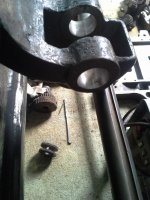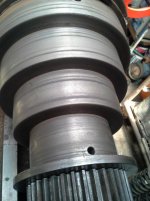How to install the app on iOS
Follow along with the video below to see how to install our site as a web app on your home screen.
Note: This feature may not be available in some browsers.
You are using an out of date browser. It may not display this or other websites correctly.
You should upgrade or use an alternative browser.
You should upgrade or use an alternative browser.
smith barker and willson lathe
- Thread starter macsonboy
- Start date
- Replies 51
- Views 8,643
Limy Sami
Diamond
- Joined
- Jan 7, 2007
- Location
- Norfolk, UK
No, but FYI Smith, Barker and Willson - Graces Guide
P.S. This is not a 144 character / $5 a letter forum, ............more input from you will likely yield better results.
P.S. This is not a 144 character / $5 a letter forum, ............more input from you will likely yield better results.

johnoder
Diamond
- Joined
- Jul 16, 2004
- Location
- Houston, TX USA
Looking at Limy's link, I'd guess between 1899 and 1912
would really like to know the date of my lathe
john.k
Diamond
- Joined
- Dec 21, 2012
- Location
- Brisbane Qld Australia
The reference to Graces Guide.....CF Limy Sami.......Apparently the best youll get ,without doing your own legwork.
johnoder
Diamond
- Joined
- Jul 16, 2004
- Location
- Houston, TX USA
could you please tell me what is a limys link?
The underlined bit in Post #2 - that is a link, and forum member Limy Sami posted that post #2
I "looked" at that by clicking on same
hi all i am still bumbling around on this site and need any help i can get,i am trying to restore a smith barker and willson lathe from about 1915 roughly and have started on the headstock area.this is a flat belt job and i need to know do i lightly turn down the belt drums to clean them up or just use grit paper of some sort.the drum assembly is heavy cast iron by the look of it and it is very heavy .the lathe is 60 inches long on the bed and weighs approx 1 1/2-2 tons.
Limy Sami
Diamond
- Joined
- Jan 7, 2007
- Location
- Norfolk, UK
I'll start you off (but I'm not spoon feeding you) those pulley sheaves should be slightly crowned (if they aren't the belt comes off!!) so unless they are badly worn, just clean them up with grit paper / cloth, .............posting some pics will help us to help you, ....cos believe it or not, we ain't psychic 

enginebill
Stainless
- Joined
- Feb 17, 2005
- Location
- Plymouth Meeting PA
I would just use emery paper and do not machine them unless absolutely necessary, the cone pulleys are crowned to keep the belt centered. Some pictures of the lathe would help us out.
Joe Michaels
Diamond
- Joined
- Apr 3, 2004
- Location
- Shandaken, NY, USA
A little surface roughness on the surface of a flat belt pulley will not hurt anything. In fact, it will increase belt friction- reducing chances of belt slippage by some small amount. Flat belts rely on friction to transmit power. If the contact surface of a flat belt pulley were highly polished, it would be to no advantage and might actually reduce the amount of power the belt could transmit. The power a belt can transmit is a function of a number of things, not the least of which are:
belt wrap (the angle or amount of circumference which the belt wraps around the pulley)
coefficient of friction between the belt and the pulley
In actuality, a properly designed flat belt drive would have sufficient wrap and sufficient friction to transmit the power with very little pre-tensioning of the belt.
Take some fairly coarse abrasive paper, knock off the loose rust, and your lathe will be fine.
We will work with you as you add posts about your progress with your lathe, but we tend to be a bit of a tough group. Namely, we expect a person to use their God-given gifts of mind, senses, and develop manual skills to figure out and repair and use what they are inquiring about (lathes, old tools, etc). I am old enough to remember walking to the public library to get information, and now, the world is quite literally at our fingertips with this thing they call the internet. Try to figure stuff out, see what you can learn online if you hit a wall, and then come to us. We are happy to help you, but, as I said, some of us (such as myself) are old farts, or crumudgeons.
belt wrap (the angle or amount of circumference which the belt wraps around the pulley)
coefficient of friction between the belt and the pulley
In actuality, a properly designed flat belt drive would have sufficient wrap and sufficient friction to transmit the power with very little pre-tensioning of the belt.
Take some fairly coarse abrasive paper, knock off the loose rust, and your lathe will be fine.
We will work with you as you add posts about your progress with your lathe, but we tend to be a bit of a tough group. Namely, we expect a person to use their God-given gifts of mind, senses, and develop manual skills to figure out and repair and use what they are inquiring about (lathes, old tools, etc). I am old enough to remember walking to the public library to get information, and now, the world is quite literally at our fingertips with this thing they call the internet. Try to figure stuff out, see what you can learn online if you hit a wall, and then come to us. We are happy to help you, but, as I said, some of us (such as myself) are old farts, or crumudgeons.
ratbldr427
Titanium
- Joined
- Mar 21, 2006
- Location
- jacksonville,fl.
I've seen a few flat belt cones but haven't seen any worn that bad. I have a 1914 American and had a 1924 Dalton no wear like that. I wonder if it was run with slipping v-belts? The photos may make them look worse than they are. If it was mine and I was going to run flat belts I would probably re crown them If there is enough meat there.
thank you limy sami for your help. just for the record i am not a machinist or fitter and turner by a long stretch but do like it all. i am a motor mechanic for the past 40 odd years and know my way around a modern car but not so much a lathe,but have purchased a novar milling machine,macson lathe and am kenn to get started.
Limy Sami
Diamond
- Joined
- Jan 7, 2007
- Location
- Norfolk, UK
Cheers fopr that - you'll find a lot of info on restoring machines of your era etc etc here lathe restoration blogs - Google Search
Just needs a good search - IMHO the South Bends would be a good starting point to help with the SBW.
Just needs a good search - IMHO the South Bends would be a good starting point to help with the SBW.
Limy Sami
Diamond
- Joined
- Jan 7, 2007
- Location
- Norfolk, UK
Nice job ....only I hope that's wedded as in marriage, ............ and not a typo for welding 

for an update to my smith barker and willson project,on the first pic is a cast bracket which helps to drive the auto feed and the rod goes through it,but the holes in that bracket are flogged out so i have made some bushes,so far so good ,but now comes the problem,it is easy to think open up the holes and put the bushes in and hone or ream to required clearance (what could go wrong?). to open up these holes true and not forgetting that a 9 foot long shaft must also be happy in its new home, how on earth do i mount it in the mill and find a true reference point to make sure the holes are right in line.i will try to put up more pics to help explain. any thoughts welcome



Last edited:
Similar threads
- Replies
- 0
- Views
- 1K






